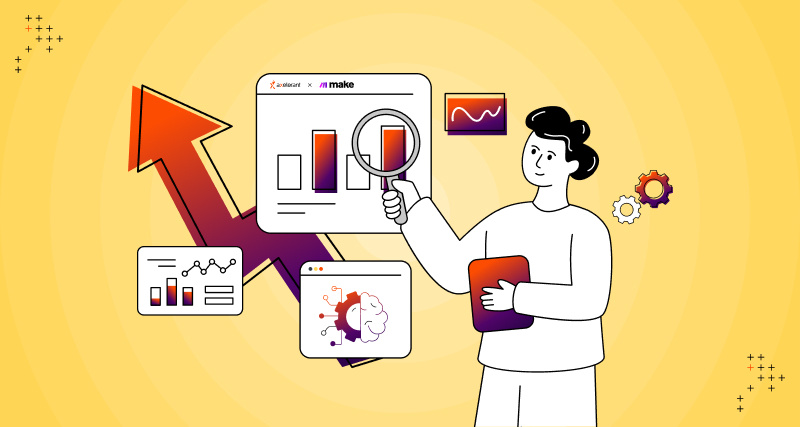When building a high-performing company culture, set behaviors and norms are needed to lead an organization to achieve superior results.
An efficient and unbiased appraisal system is one crucial aspect of this. Like any other process, it takes time to perfect. To build a thriving work culture and dynamic team environment, organizations must accurately reflect employee contributions and, hence, create a cycle of continuous improvement.
Intelligent automation is emerging as a transformative force in this area, offering a path to more efficient and unbiased evaluations.
Why Change Traditional Systems?
Performance appraisals have existed for almost as long as business itself. However, over time, organizations are realizing that this process is dated.
Employees generally want appraisals completed quickly, and typical performance management systems create more problems than they solve.
In this context, technology and automation can provide significant benefits, for example, take Adobe.
Adobe made a bold decision in 2012 to automate the annual review and replace it with a continuous feedback system.
The results? Time was freed up to concentrate on growth strategies.
The improvement in morale led to an improvement in hard numbers as well. Adobe saw a 30% decrease in employees quitting and a 50% increase in involuntary departures.
The company returned most of the 80,000 hours managers spend annually on annual reviews.
This brings us back to acknowledge that automated appraisal systems help develop a more successful goal-accomplishing strategy.
Ultimately, appraisals must accomplish three things: review contributions, reward accomplishments, and provide two-way feedback.
Do they need to be conflated into a cumbersome process?
We don’t think so.
Why Did We Create The Automated Appraisal System At Axelerant?
Common methods like calibration meetings and multiple raters were falling short:
- Calibration meetings aligned evaluation standards across the organization, but they were time-consuming and still subject to human error.
- Multiple rater outcomes were inconsistent due to differing perspectives.
We fuel our systems by thinking radically differently, and when it came to our people, we started exploring the opportunity to abolish our ‘annual review.’
In its place, we introduced an automated salary revision system backed by sound business logic.
We started focusing on creating a fair, efficient, and engaging system. That led us to identify gaps in the market, like real-time feedback, unbiased evaluations, and actionable insights.
Intelligent Automation: The Solution
With our IA capabilities they helped us ensure objectivity, standardize criterias and connect with larger processes to create a rock solid system:
- We brought down the annual review time that previously took three months to complete. Now, they are handled in a recurring two-week monthly cycle, focusing on outliers rather than justification.
- Much of the administration is automated and all changes are completed before the month-end payroll, allowing employees to enjoy their raises promptly.
- We automated notifications and system updates, eliminating delays caused by manual effort and other priorities.
- We completed role recognition changes before month-end, automatically updating systems and email signature blocks.
Our monthly handling of promotions led to refinements, making the process smoother and more user-friendly.
How Did We Do It?
The Process In a Nutshell

A Make Run Down
PO 700II Salary Revision Notices
- Automates salary revision notifications, integrating with Google Sheets, Slack, and Zoho People.
- Manages communication through configurable workflows and error handling mechanisms.
- Ensures timely and accurate salary revision updates for team members.


PO-AUTO351 New Role Monitor
- Monitors and updates role recognition data in Google Sheets.
- Ensures accurate and timely information transfer across different sheets.

PO-AUTO351 Role Revision Letter Sending
- Automates sending role revision letters by setting variables for personaliz data.
- Filters rows from Google Sheets and sends documents through PandaDoc.
- Notifies recipients and admin team via Slack about the status of role revision letters.


PO-AUTO351 Zoho People Role Transition
- Automates updating role transitions for employees in Zoho People.
- Checks and updates Google Sheets entries related to roles, salaries, and appraisals.
- Sends notifications via Slack.

PO AUTO-402 Send Signed PandaDoc Letter
- Automates sending signed PandaDoc letters.
- Verifies document statuses.
- Notifies relevant people via Slack.
- Updates corresponding records in Google Sheets and Zoho People.


PO AUTO-413 Career Manager Revision Notices
- Sends salary revision notifications to career managers, Using data from Google Sheets and a custom data store.

Fostering Growth Through Our System
People work better and contribute more when they don't have to haggle for salary increments. Our automation system allows for more focus on people-centric initiatives, ensuring consistent, fair, and sustainable satisfaction.
Holistic Insights Led By Data Integration
We combined diverse data sources, from performance metrics to feedback loops, to gain comprehensive insights into employee performance and organizational dynamics.
“Our Managers saved about three hours per team member, equivalent to a week or two of work for some managers.This time was now being applied to more efficient management planning.” - Michael Cannon, Director of Intelligent Automation, Axelerant.
HRIS Integration
We integrated with HR Information Systems (HRIS) to enable seamless data flow, informed HR strategies, and correct person notifications.
Continuous Feedback
Using standard systems and methodologies for feedback and reviews, we've enabled employees with near real-time feedback and adaptive insights, fostering a learning and professional development culture.
Goal Adoption Based On Real-Time Analytics
Our engagement platform supports dynamic goals based on data inputs, ensuring alignment with organizational priorities and employee capabilities. We developed a skills matrix to clarify role expectations, helping employees understand what they need to reach the next level.
Trust And Accountability
We built the structure transparently, establishing clear accountability measures for appraisal outcomes and building trust among stakeholders. Our stable system allowed employees to focus on their jobs.
A Checklist For Implementation
- Assessment Of Current Processes: Begin by evaluating existing appraisal methods and identifying pain points that automation can address.
- Define Objectives: Clearly define the goals and metrics for the new automated system, aligning them with organizational objectives.
- Select The Right Technology: Choose an automation platform that meets your organization's needs, considering scalability, integration capabilities, and user-friendliness.
- Customization: Customize the automation platform to fit your appraisal processes and organizational structure.
- Pilot Testing: Conduct a pilot test of the automated system with a small group of employees or departments to identify any issues.
- Training: Provide training sessions for all teams and employees on using and understanding the new system effectively.
- Data Migration And Integration: Ensure migration of data from existing systems to the new automation platform.
- Feedback Mechanisms: Establish feedback mechanisms to gather input from users post-implementation.
A Smooth Transition
- Phased Rollout: Implement the new system in phases rather than all at once.
- User Support: Provide ongoing support and assistance to employees during the transition period.
- Continuous Communication: Maintain open and transparent communication throughout the transition.
- Training Refreshers: Offer refresher admin training as needed to reinforce consistency.
Conclusion
“Automation has greatly enhanced the joy we find in our work. “- Kanika Bhatia, Axelerant
Axelerant has seen firsthand how transformative intelligent automation can be for organizational culture. It's not just about streamlining processes, it's about fostering an environment where fairness, transparency, and continuous growth are the norm.
For any organization, this shift from traditional methods to intelligent automation isn't merely an operational improvement; it's a strategic move towards creating a more engaged and high-performing workforce and, hence, is inevitable.
Explore the Intelligent Automation services at Axelerant and book a one-on-one consultation so we can help you better understand your needs.
Do you have questions or just want to share your experiences? Comment away, and we will get back to you!

Michael Cannon, Director of Intelligent Automation
Living remotely in Taiwan with 4 incredible sons, 3 playful cats, and one fiery partner. As Director of Intelligent Automation @Axelerant, they are dedicated to building trust in Axelerant as your go-to agency partner through their journey in #Automation, #Empowerment, and #Productivity.

Saakshi Dutta, Marketing Associate
A free-spirited and eccentric explorer, Saakshi brings fresh perspectives to every endeavor—continually looking up at the stars and pushing boundaries. She is passionate about photography, filmmaking, and trekking, always eager to discover new places and tell stories that often go unheard.

 We respect your privacy. Your information is safe.
We respect your privacy. Your information is safe.
Leave us a comment